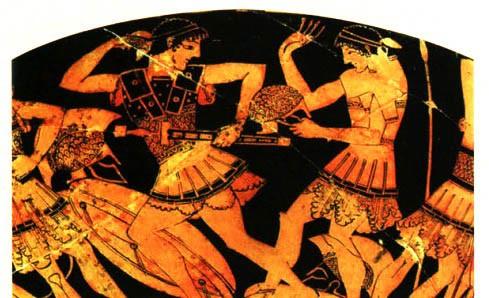
The mystery of the Trojans and the Greeks
The mystery of life is perhaps the greatest, but not the only mystery of our System over which scientists are racking their brains. There are others, for example, the Trojans and the Greeks, i.e. two groups of asteroids revolving around the Sun in orbits very similar to the orbit of Jupiter (4). They are concentrated around the points of libration (the tops of two equilateral triangles with the base being the Sun-Jupiter segment).
4. Trojans and Greeks orbiting Jupiter
Why are there so many of these objects and why are they so strangely arranged? In addition, "on the route" of Jupiter there are also asteroids belonging to the "Greek camp", which overtake Jupiter in its orbital motion, moving around the libration point L4, located in an orbit 60 ° ahead of the planet, and belonging to the "Trojan camp" follow behind the planet, near L5, in an orbit 60° behind Jupiter.
What to say about Kuiper belt (5), whose functioning, according to classical theories, is also not easy to interpret. In addition, many objects in it rotate in strange, unusually inclined orbits. Recently there has been a growing opinion that the anomalies observed in this region are caused by a large object, the so-called ninth planet, which, however, has not been directly observed. Scientists are trying to deal with anomalies in their own way - they are building new models (6).
5 The Kuiper Belt Around The Solar System
For example, according to the so-called Nicene model, which was first presented in 2005, our solar system was much smaller at first, but a few hundred million years after its formation planet migration to further orbits. The Nice model provides a potential answer to the formation of Uranus and Neptune, which are too distant orbits to form even in the early solar system because the local density of matter was too low there.
According to Francesca DeMeo, a scientist at the US Harvard-Smithsonian Center for Astrophysics (CfA), Jupiter was as close to the Sun in the past as Mars is now. Then, migrating back to its current orbit, Jupiter destroyed almost the entire asteroid belt - only 0,1% of the asteroid population remained. On the other hand, this migration also sent small objects from the asteroid belt to the outskirts of the solar system.
6. Various models of formation of planetary systems from matter protodisks.
Perhaps the migration of gas giants in our solar system also caused asteroids and comets to collide with Earth, thus supplying our planet with water. This could mean that the conditions for the formation of planets with features such as the Earth's surface are quite rare, and life could more often exist on icy moons or massive ocean worlds. This model could explain the strange location of the Trojans and Greeks, as well as the massive asteroid bombardment that our cosmic region experienced about 3,9 billion years ago and whose traces are so clearly visible on the surface of the Moon. It happened on Earth then Hadean era (from Hades, or ancient Greek Hell).
